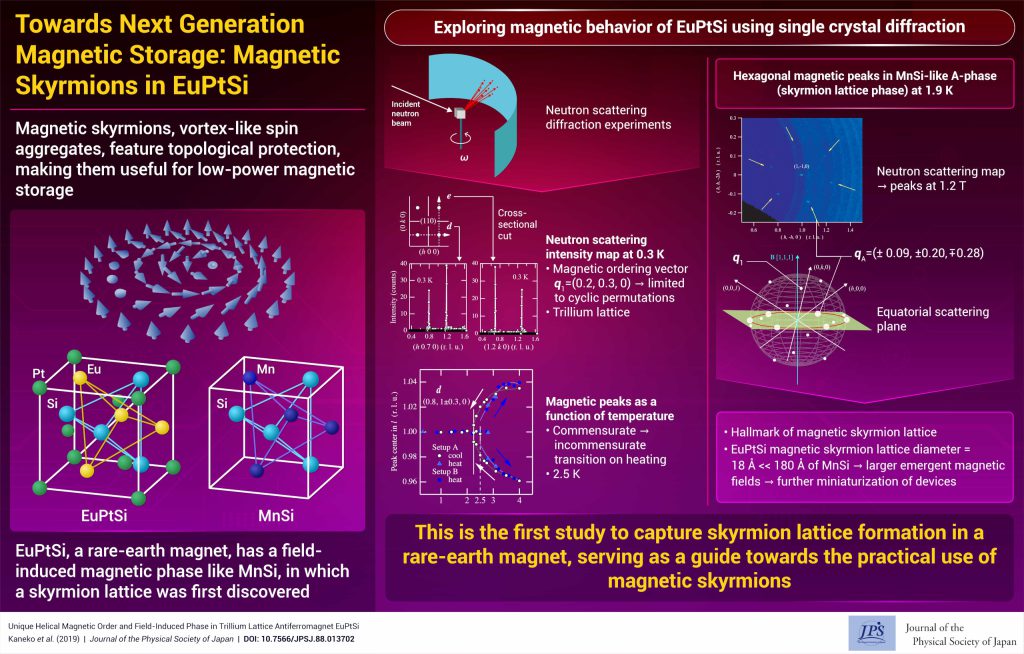Towards Next Generation Magnetic Storage: Magnetic Skyrmions in EuPtSi
© The Physical Society of Japan
This article is on
Unique Helical Magnetic Order and Field-Induced Phase in Trillium Lattice Antiferromagnet EuPtSi
(The 29th Outstanding Paper Award of the Physical Society of Japan)
J. Phys. Soc. Jpn.
88,
013702
(2019)
.
This study explores the magnetic behavior of rare-earth magnet EuPtSi using single-crystal neutron diffraction, potentially revealing magnetic skyrmion lattice formation.

Magnetic skyrmions are nanoscale, vortex-like collections of magnetic moments that appear in some magnetic materials. These are arranged in a stable, swirling pattern, forming a topologically protected structure, meaning that they cannot be easily destroyed or transformed. This stability, and the ability to be driven by ultra-low currents, make magnetic skyrmions promising for next-generation ultra-low power magnetic storage devices.
In 2009, small skyrmion lattices were first discovered in the 3d electron system of Manganese monosilicide (MnSi) under magnetic fields, demonstrating a topological Hall effect. This discovery spurred intensive research on skyrmions, leading to the discovery of similar phenomena in other 3d electron systems.
Europium-platinum-silicon (EuPtSi), an intermetallic compound, is characterized by a non-centrosymmetric cubic structure known as a trillium lattice, somewhat similar to MnSi’s structure. In 2018, a field-induced state was found in a limited region of the phase diagram of EuPtSi, resembling the A phase of MnSi, which hosts the skyrmion lattice. An unusually large Hall effect was also observed in this phase, likely arising from topological effect.
Motivated by these findings, in this study, we investigated the magnetic behavior of EuPtSi using single-crystal neutron diffraction. Our results showed that at a temperature of 0.3 K, EuPtSi exhibited a helical magnetic order, characteristic of its trillium lattice structure. Upon heating, at about 2.5 K, it undergoes a first-order transition from commensurate to an incommensurate magnetic phase. Our results showed that at a temperature of 0.3 K, EuPtSi exhibited a commensurate helical magnetic order, that transforms into incommensurate phases at the first-order transition at about 2.5 K. This reflects chiral nature of its trillium lattice structure.
Under a vertical magnetic field of 1.2 Tesla, at 1.9 K, EuPtSi enters the so-called A phase, where magnetic peaks form hexagonal patterns in the equatorial scattering plane. This field-induced transition is the hallmark of skyrmion lattice formation in EuPtSi.
Notably, the magnetic skyrmion lattice in EuPtSi has a significantly smaller diameter of 18 Angstrom, compared to 180 Angstrom in MnSi, resulting in a hundred times higher density and potentially larger emergent magnetic fields, leading to a larger Hall effect, as found in the previous study. This could enable further miniaturization of magnetic skyrmion-based devices.
This study is the first to capture skyrmion lattice formation in an Eu-based rare-earth magnet, offering effective approaches for investigating magnetism in Eu-based compounds. Due to its potential in guiding further exploration of magnetic skyrmion lattices in rare-earth compounds, this study was honored with the Outstanding Paper Award of the Physical Society of Japan.
Overall, this study marks a significant step forward toward practical applications of magnetic skyrmions, with the potential to revolutionize electronics.
Unique Helical Magnetic Order and Field-Induced Phase in Trillium Lattice Antiferromagnet EuPtSi
(The 29th Outstanding Paper Award of the Physical Society of Japan)
J. Phys. Soc. Jpn.
88,
013702
(2019)
.
Share this topic
Fields
Related Articles
-
Higher-Order Topological Phases in Magnetic Materials with Breathing Pyrochlore Structures
Electronic structure and electrical properties of surfaces and nanostructures
Magnetic properties in condensed matter
Mathematical methods, classical and quantum physics, relativity, gravitation, numerical simulation, computational modeling
2025-4-7
A simple example of a higher-order topological phase, in which the symmetry decreases step-by-step from the bulk to the corner, is realized in a magnetic system with a pyrochlore structure and is characterized by a series of quantized Berry phases defined for the bulk, surface, and edge.
-
Existence of Chiral Soliton Lattices (CSLs) in Chiral Helimagnet Yb(Ni1-xCux)3Al9
Magnetic properties in condensed matter
2025-4-1
Our study examines the magnetic structure of the monoaxial chiral helimagnet Yb(Ni1-xCux)3Al9, providing first direct evidence of the formation of chiral soliton lattice state.
-
Understanding Pressure-Induced Superconductivity in CrAs and MnP
Magnetic properties in condensed matter
2025-3-10
This study reviews existing research on the pressure-induced variation of magnetic properties of transition metal mono-pnictides like CrAS, MnP, and others, aiming to understand the unconventional superconductivity observed in CrAs and MnP.
-
Symmetry and AI: Building the Future of Physics Simulations
Magnetic properties in condensed matter
Measurement, instrumentation, and techniques
2025-2-18
Generative artificial intelligence (AI) has gained considerable attention in scientific fields. By embedding physical symmetry into AI before training, we created a faster and lighter model. Scaling improves the accuracy and unlocks the potential of physics research and applications.
-
Triangular Lattice Magnet GdGa2: Spin Cycloids and Skyrmions
Cross-disciplinary physics and related areas of science and technology
Electronic transport in condensed matter
Magnetic properties in condensed matter
2025-2-3
Careful measurements were conducted on the hexagonal magnet GdGa2 to reveal the experimental signatures of ultrasmall spin cycloids and of a potential Néel-type skyrmion lattice phase induced by a magnetic field.




